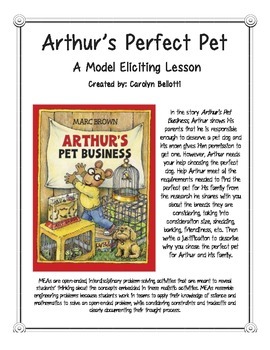Arthur's Perfect Pet MEA (Model Eliciting Activity)
Homeschool of Love Resources
237 Followers
Grade Levels
1st - 3rd
Standards
CCSS1.NBT.B.3
CCSS2.NBT.A.4
CCSSRL.1.3
CCSSRL.2.3
CCSSSL.1.1
Formats Included
- Zip
Pages
13 pages
Homeschool of Love Resources
237 Followers
Description
Set includes lesson plan and guidelines for implementation, 2 data sets, 2 reading passages, 2 letter templates, graphic organizer, and rubric for grading.
Summary: In the story Arthur's Pet Business, Arthur shows his parents that he is responsible enough to deserve a pet dog and his mom gives him permission to get one. However, Arthur needs your help choosing the perfect dog. Help Arthur meet all the requirements needed to find the perfect pet for his family from the research he shares with you about the breeds they are considering, taking into consideration size, shedding, barking, friendliness, etc. Then write a justification to describe why you chose the perfect pet for Arthur and his family.
MEAs are open-ended, interdisciplinary problem-solving activities that are meant to reveal students’ thinking about the concepts embedded in these realistic activities. MEAs resemble engineering problems because students work in teams to apply their knowledge of science and mathematics to solve an open-ended problem, while considering constraints and tradeoffs and clearly documenting their thought process. This early elementary MEA based on a favorite Arthur book will require your students to put their problem solving skills to the test!
Summary: In the story Arthur's Pet Business, Arthur shows his parents that he is responsible enough to deserve a pet dog and his mom gives him permission to get one. However, Arthur needs your help choosing the perfect dog. Help Arthur meet all the requirements needed to find the perfect pet for his family from the research he shares with you about the breeds they are considering, taking into consideration size, shedding, barking, friendliness, etc. Then write a justification to describe why you chose the perfect pet for Arthur and his family.
MEAs are open-ended, interdisciplinary problem-solving activities that are meant to reveal students’ thinking about the concepts embedded in these realistic activities. MEAs resemble engineering problems because students work in teams to apply their knowledge of science and mathematics to solve an open-ended problem, while considering constraints and tradeoffs and clearly documenting their thought process. This early elementary MEA based on a favorite Arthur book will require your students to put their problem solving skills to the test!
Total Pages
13 pages
Answer Key
N/A
Teaching Duration
1 Week
Last updated Sep 14th, 2015
Report this resource to TPT
Reported resources will be reviewed by our team. Report this resource to let us know if this resource violates TPT’s content guidelines.
Standards
to see state-specific standards (only available in the US).
CCSS1.NBT.B.3
Compare two two-digit numbers based on meanings of the tens and ones digits, recording the results of comparisons with the symbols >, =, and <.
CCSS2.NBT.A.4
Compare two three-digit numbers based on meanings of the hundreds, tens, and ones digits, using >, =, and < symbols to record the results of comparisons.
CCSSRL.1.3
Describe characters, settings, and major events in a story, using key details.
CCSSRL.2.3
Describe how characters in a story respond to major events and challenges.
CCSSSL.1.1
Participate in collaborative conversations with diverse partners about grade 1 topics and texts with peers and adults in small and larger groups.





